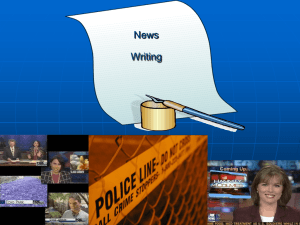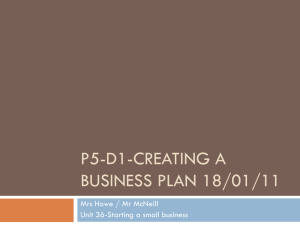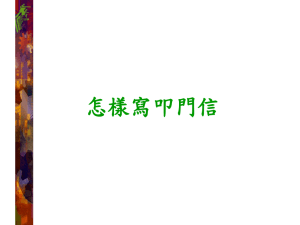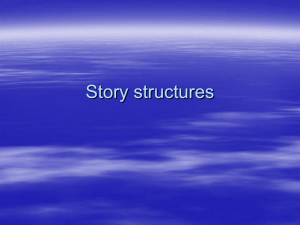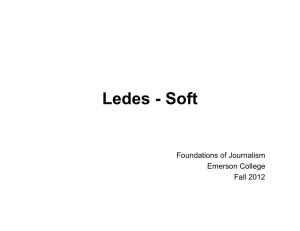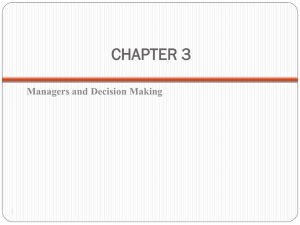Tips to Interview & Write Like a Pro
advertisement
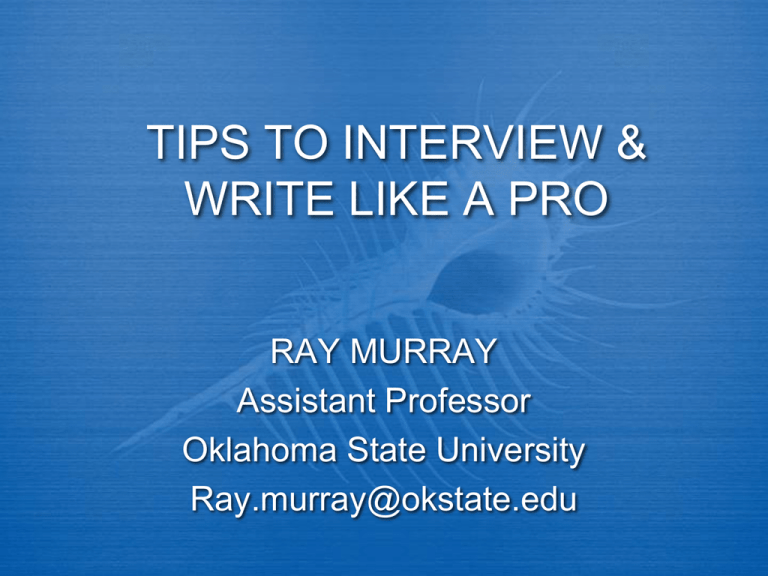
TIPS TO INTERVIEW & WRITE LIKE A PRO RAY MURRAY Assistant Professor Oklahoma State University Ray.murray@okstate.edu INTERVIEWING BASICS When you’re interviewing someone, what’s your most important skill? Listening. Do your homework before going to an interview. Try to make it a conversation and not a cross examination. GET MOVIN’ Ask politely for interview time. What time works best? Office? Home? Coffee shop? You’re busy, they’re busy, so don’t put it off. Rush jobs are obvious and stink. Please and thank you go a long way. KEEPING CHASING “I e-mailed him two weeks ago and he hasn’t e-mail me back.” “I left a message for him and he hasn’t called me back.” Keep digging/chasing. It’s amazing how few students think of GOING TO MEET THE PERSON IN PERSON. It’s allowed and encouraged. LITTLE THINGS ARE BIG Show up 10 minutes early. Make sure you know where you’re going. Make sure you have a notebook, plenty of WORKING pens. Should you record it? Yes, but take notes. Check the machine during the interview to see whether it’s working. Carry extra batteries/tapes. LITTLE BIG THINGS Dress appropriately; “young professional” and not “college kid with holes in my pants, my butt hanging out and my hat on backward.” Put your source at ease; get him/her talking by mentioning something on the walls or the weather or ain’t the Cowboys great. GROUND RULES Everything is on the record. Say it’s possible this will be submitted for publication. Don’t agree to a list of questions. Don’t let them review the story. Conduct an accuracy check on needed items. NO anonymous sources. WHOM TO INTERVIEW Highest officials possible. Experts on an issue. People with opposing views. People affected. Diverse sources. ONCE YOU GET GOING Give the source an overview of what you plan to talk about. Start with open-ended questions; listen, listen, listen. Be prepared to change directions if the source says something that dictates it. Observe your surroundings/take notes that help give the story flavor. FIRST THINGS FIRST First question to ask . . . “May I have the correct spelling of your first and last names?” People will like that you’re trying to be accurate. Second question: “May I have your home/work phone number(s)/email/Blackberry/what gadget you have addresses so I may call or text you later if I have more questions?” NOW WE’RE ROLLIN’ Ask the easy questions first to get the source talking. Open-ended questions are good. Save the tough stuff for the end. “Did you embezzle $2 million from the bank?” SILENCE IS GOLDEN Don’t be afraid of silence. It can help the source get organized. Keep questions short; let the source do most of the talking. Highlight the good stuff. Mark tape number. FAVORITE QUESTIONS From Pat Stith, a retired investigative reporter for the Raleigh News and Observer: Why? What makes you say that? How do you know? How am I going to explain that to people in …? Another I like: Explain this to me as if I’m a third-grader. WRAP IT UP Two questions to ask at the end of the interview: “Is there anything else you think we need to discuss?” “Is there anyone else I should talk to about this story?” Let the source get the last word. AFTERWARD Tell the source you will call back if you have any questions or need clarification on anything. Review your notes quickly; don’t wait three days and then you can’t read your handwriting. Transcribe the tape soon so the interview is fresh in your mind. NOW WHAT? Writing is easy. As Red Smith said, “You sit down and open up your wrists.” WRITING AS A JOURNALIST What are the six keys to good journalistic writing? Short paragraphs Short sentences Short words Be objective Follow style rules Know the journalism story formulas and how to use them. STORY ORGANIZATION Traditional Structure: Inverted Pyramid Present the news in order of descending importance. Lede summarizes the news. Each of the following paragraphs presents additional information in order of descending importance. INVERTED PYRAMID Advantage: Least important information is at the bottom where a cut in length is most likely to occur. Disadvantage: Doesn’t give the reporter a clear direction on how to report beyond who, what, when, where, how and why. INVERTED PYRAMID The Inverted Pyramid often can use an Immediate ID lede. The name is in the lede. The name must be well-known, at least to the area. President Barack Obama vetoed a bill that would have given OSU students $20,000 each to go to Cancun. HIGH FIVE New Way of Thinking: The High Five News Context Scope Edge Impact Reporting and writing are connected. You can't write what you don't know. Think of the High Five as a checklist. The idea is to make you: think about the stories you report; ask questions about why the news occurred and where it's leading; seek details that will help you tell news with precision; and raise questions that your readers may want answered. GET TO IT Get these five elements into the top five or six paragraphs: News: What happened, or what is happening? Context: What is the background for the event or trend? Scope: What is the magnitude of the event? How many people are affected? Is this local event part of a larger, national set of events? Is there a local focus to this larger, national event? Think numbers. Edge: Where is the news leading? What happens next? What is the time element? What is the next development? Impact: So what? How does the news affect anything? Why should the reader care? A good quote can often be an impact. Remember, the elements must appear in the first five to six paragraphs. News must be in the lede. Other elements can appear in any order. Some elements can overlap. The High Five should be on the first page (OK, a line may spill over). High Five Practice Story A State University student said the board of trustees’ decision to eliminate a religious studies program was done to punish professors who testified against the university in a lawsuit. (NEWS) The board of trustees decided Friday to end the program as a cost-cutting measure unless it is able to attract more students by next year. Religious studies is an interdisciplinary program that was begun in 1980. State University had 20 religion minors last year but now has only 15, a drop of 25 percent. (CONTEXT/SCOPE) Thomas Efraim, a student in the minor, said he believes the professors in the program are being targeted because two of them testified on his behalf when he unsuccessfully sued the university three months ago for the right to be excused from a science requirement he said violated his religious beliefs. Professors Peter Hinkleson and Keshia Bernard testified on Efraim’s behalf. (CONTEXT) Bernard, who coordinates the religious studies program, said she received a letter from university president Ned Dallas informing her that if the minor is eliminated, some faculty members could lose their jobs if they cannot find other courses to teach. She received the letter one week after Efraim lost his lawsuit. (IMPACT) Supporters of the program are attempting to recruit more students to the minor by putting up posters and holding midweek discussions on religion. Efraim will speak about his lawsuit at this week’s meeting, and Hinkleson said he plans to meet with Dallas to discuss the program. (EDGE) . . . Then the rest of the story…
